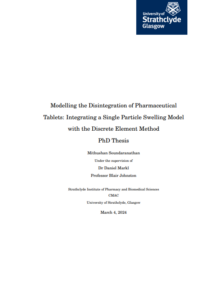Thesis on modelling the disintegration of pharmaceutical tablets
We strongly recommend reading this thesis, emphasizing on modelling the disintegration of pharmaceutical tablets by Mithushan Soundaranathan, University of Strathclyde, 2024. CELLETS® have been employed as model particles at different sizes, such as CELLETS® 500, CELLETS® 700, and CELLETS® 1000.
Titel of Thesis: Modelling the disintegration of pharmaceutical tablets: integrating a single particle swelling model with the discrete element method
Downloadable Content: Download PDF
Creator: Soundaranathan, Mithushan
Rights statement: Strathclyde Thesis Copyright
Awarding institution: University of Strathclyde
Date of award: 2024
Thesis identifier: T16863
Department, School or Faculty: Strathclyde Institute of Pharmacy and Biomedical Sciences, CMAC National Facility.
The thesis aims to develop a comprehensive model of tablet disintegration, crucial for drug absorption. It analyzes key mechanisms including liquid imbibition, swelling, and inter-particulate bond breakup. Tablet disintegration involves interconnected processes like liquid penetration, swelling, dissolution, and break-up, with liquid penetration initiating particle swelling and subsequent tablet breakdown. Internal swelling stress must surpass bond strength for disintegration to occur. Interdependence exists among disintegration mechanisms, as particle swelling affects pore structure, influencing liquid penetration. The study develops a model incorporating tablet compaction, swelling, and liquid penetration, implemented in Yade-DEM software. Finally, results indicate pore closure hindering swelling and disintegration, impacted by porosity and disintegrant concentration. In conclusion, the employed model successfully captured variations in tablet swelling behavior. Notably, increasing disintegrant concentration enhances tablet permeability but prolonged swelling time, while decreasing porosity increases the maximum swelling time. Overall, the thesis highlights the complex interplay of factors influencing tablet disintegration and underscores the utility of modeling and simulation in understanding and optimizing this process for pharmaceutical formulations.
CELLETS® are made from pelletization of microcrystalline cellulose. These pellets are a stable cores for drug loading by coating with various layers of functional excipients and active pharmaceutical ingredients to achieve specific release profiles, such as immediate release, sustained release, or targeted release. Pharmaceutical formulations based on CELLETS® offer several advantages over traditional dosage forms, enhanced bioavailability, including reduced side effects, and enhanced patient compliance (with tremendous effects on paediatrics or geriatrics). They are commonly used in the development of modified-release formulations for a wide range of solid drugs.
Additionally, these starter beads are frequently used for scientific research and a list of scientific publications can be found here.


 ingredientpharm
ingredientpharm